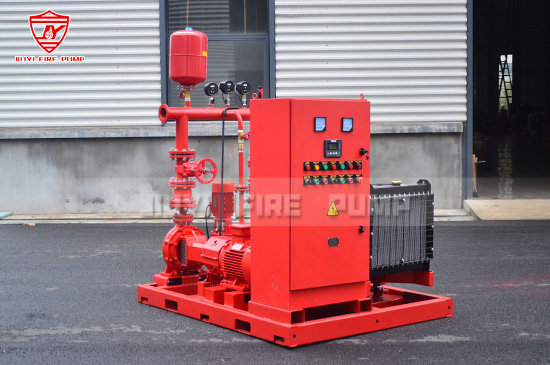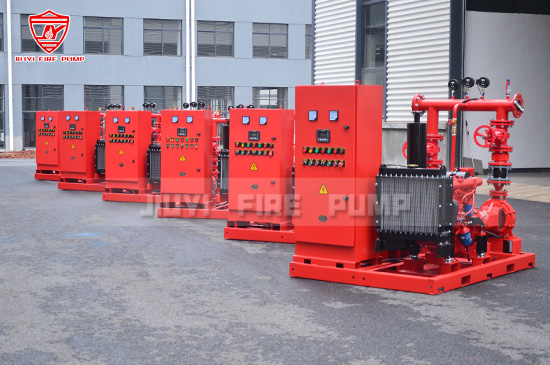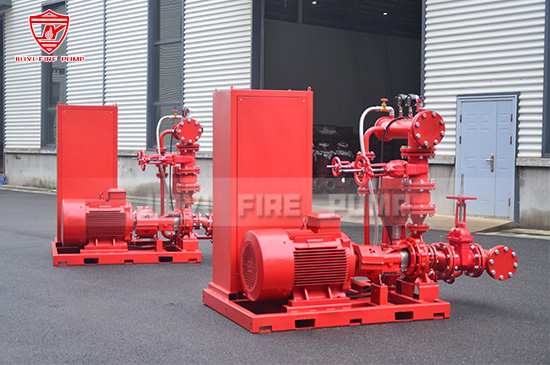Fire pumps play a critical role in fire protection systems by ensuring that adequate water pressure and flow are available when needed most. However, one of the most common issues faced by facility managers, engineers, and fire safety professionals is low pressure in fire pumps.
Low pump pressure can lead to insufficient water supply during a fire emergency, creating severe safety risks and potential non-compliance with NFPA 20 and FM Global standards. In this guide, we will explain the common causes of low pressure, step-by-step troubleshooting methods, and preventive measures to maintain optimal fire pump performance.

Before diving into troubleshooting, it’s important to understand how fire pump pressure is generated and controlled.
A fire pump’s pressure depends on:
Pump type – Vertical turbine, split-case, end-suction, or inline.
Driver type – Electric motor or diesel engine.
Water supply – From a tank, reservoir, or municipal system.
System demand – Pressure losses due to piping, elevation, and flow requirements.
For example:
Vertical turbine fire pumps rely on column bearings and water lift, so improper submergence can lead to low pressure.
Diesel fire pumps may suffer from RPM loss, affecting discharge pressure.
Electric fire pumps may have motor voltage or frequency issues impacting performance.
Knowing your system’s design parameters helps identify where pressure losses might originate.
There are several potential reasons why a fire pump may experience low pressure. Here are the most common causes:
Low water level in the storage tank or reservoir.
Obstruction in suction piping or clogged strainers.
Municipal water supply pressure drop.
Air entering the pump can cause cavitation, reducing output pressure.
Impeller erosion, scaling, or pitting.
Worn wear rings or mechanical seals.
Excessive bearing wear causing shaft misalignment.
Pump not designed for current system demands.
System modifications increasing friction losses.
Diesel engine fire pump: insufficient RPM, governor problems, or fuel issues.
Electric fire pump: motor under-voltage, phase imbalance, or overload.
Pressure relief valves stuck open, diverting water flow.
Fire pump controller settings not matching system requirements.
Check tank or reservoir levels.
Ensure all isolation valves are fully open.
Inspect suction strainers for blockage.
If connected to municipal supply, confirm if there’s an external pressure drop.
Ensure the suction line is submerged properly.
Check for air leaks in joints, gaskets, or valves.
Listen for cavitation noise—a distinct rattling sound indicates air entrainment.
Compare actual pressure with the pump’s rated performance curve.
Use pressure gauges at suction and discharge to measure differential pressure.
If pressure is low but flow is normal, impeller wear may be the cause.
For diesel pumps: verify RPM, fuel quality, and governor function.
For electric pumps: measure voltage, amperage, and phase balance.
Ensure the driver is capable of maintaining required speed under load.
Inspect pressure relief valves to ensure they are not stuck open.
Check fire pump controller settings for correct start/stop pressures.
Update calibration if necessary.
Verify if recent system changes increased demand.
Ensure the pump is still correctly sized for current NFPA 20 requirements.

Ensure proper bowl assembly submergence depth.
Inspect column bearings for wear.
Check impeller adjustment to maintain correct clearance.
Inspect coupling alignment between driver and pump.
Check for seal or bearing damage leading to internal leakage.
Monitor shaft vibration levels.
Confirm adequate fuel supply and quality.
Check RPM governor calibration.
Verify cooling system efficiency to avoid overheating and power loss.
Measure motor voltage and frequency under load.
Inspect for phase imbalance or voltage drop.
Ensure motor starter and controller are functioning properly.
The best way to handle low pressure problems is to prevent them. Implementing a comprehensive maintenance program helps ensure optimal fire pump performance.
Conduct weekly churn tests per NFPA 25.
Check suction and discharge gauges for abnormal readings.
Inspect packing, seals, and bearings for leaks.
Perform annual flow testing to compare actual performance to rated conditions.
Use ultrasonic flow meters or calibrated pitot gauges for accuracy.
Clean suction strainers and maintain tank levels.
Inspect foot valves in vertical turbine applications.
Regularly test controller pressure settings.
Lubricate and service pressure relief valves to prevent sticking.
Train operators on proper start-up and shutdown procedures.
Maintain detailed maintenance logs to track trends over time.
Some low-pressure issues require expert intervention, especially when:
Impeller replacement or rebalancing is needed.
Controller or driver modifications are required.
NFPA 20 compliance needs verification.
High-vibration or cavitation damage is detected.
Partnering with an experienced fire pump manufacturer or service provider ensures accurate diagnosis and faster resolution.

Low pressure in fire pumps is a critical issue that can compromise fire protection system reliability and NFPA compliance. By understanding the common causes, applying systematic troubleshooting methods, and implementing preventive maintenance practices, you can minimize downtime and ensure your fire pump system delivers optimal performance when it matters most.
As a leading manufacturer of UL-listed and NFPA 20-compliant fire pumps, we provides complete solutions for electric fire pumps, diesel engine fire pumps, vertical turbine fire pumps, and fire pump package sets. If you need expert assistance or a customized maintenance plan, contact us today to keep your fire protection systems safe and reliable.